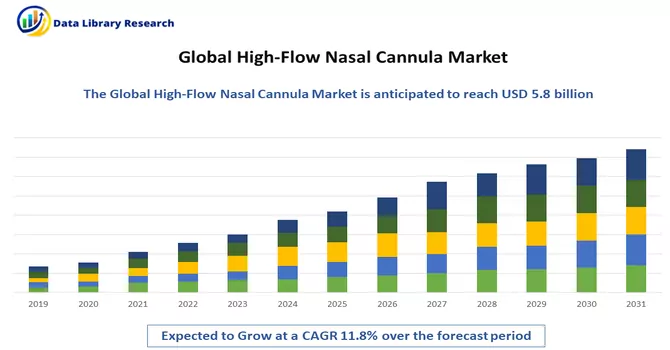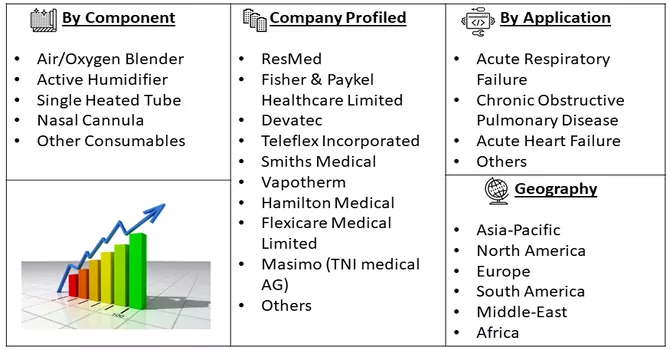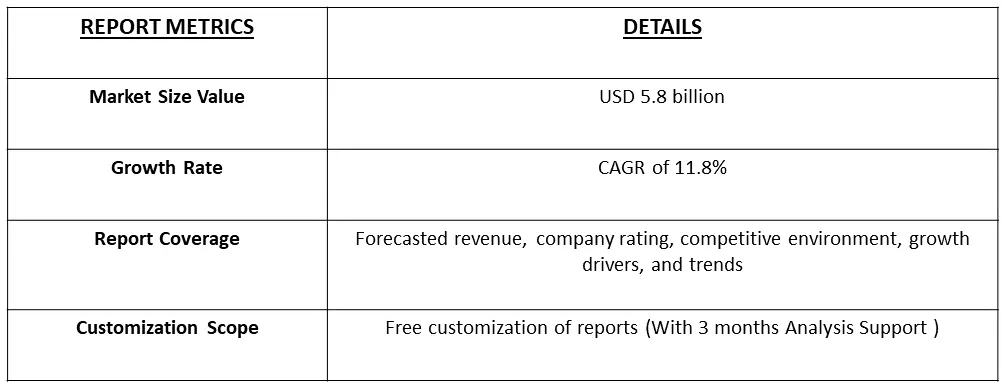In 2022, the global market for high-flow nasal cannulas (HFNC) achieved a noteworthy size, reaching USD 5.8 billion. Projections indicate a robust compound annual growth rate (CAGR) of 11.8% from 2023 to 2030.

Get Complete Analysis Of The Report - Download Free Sample PDF
HFNC, a pivotal medical device, facilitates the controlled and humidified delivery of oxygen to a patient's respiratory system. The apparatus comprises a lightweight nasal cannula—a pliable tube featuring prongs that comfortably insert into the patient's nostrils—and is seamlessly connected to a specialized machine or oxygen source. Distinguishing itself from traditional nasal cannulas, HFNC administers significantly higher oxygen flow rates, spanning from several litres per minute to an impressive 60 litres per minute or more.
A surge in the prevalence of respiratory disorders worldwide has driven the demand for effective respiratory support systems. HFNC, with its ability to deliver higher oxygen flow rates, has become a preferred choice in managing respiratory conditions, contributing significantly to market growth. Moreover, ongoing technological advancements in high-flow nasal cannula systems play a pivotal role in the market's expansion. These innovations enhance the precision, efficiency, and comfort of respiratory therapy, fostering greater adoption among healthcare providers.
Market Segmentation: The High-flow Nasal Cannula Market is segmented by Component (Air/Oxygen Blender, Active Humidifier, Single Heated Tube, Nasal Cannula, Other Consumables) by Application(Acute Respiratory Failure, Chronic Obstructive Pulmonary Disease, Acute Heart Failure, and Others), and by Geography (North America, Europe, Asia-Pacific, Middle-East and Africa, and South America). The report offers the value (in USD million) for the above segments.

For Detailed Market Segmentation - Download Free Sample PDF
The market is expected to witness significant opportunities due to the continuous advancements in respiratory care are opening up exciting possibilities for the development of nasal cannulas with superior designs, that provide users with a heightened level of comfort and an overall improved experience. Thus, such product developments are providing opportunities, thereby driving the growth of the studied market over the forecast period. Moreover, integrating nasal cannulas with monitoring technologies allows real-time tracking of respiratory parameters, enhancing the overall effectiveness of respiratory care. Also, crafting nasal cannulas specifically designed for children presents a unique market opportunity, addressing the distinct requirements and comfort levels of pediatric patients.
Market Driver:
High Incidence of Respiratory Disorders
The market is poised for growth, driven by an increasing incidence of respiratory disorders such as chronic obstructive pulmonary disease (COPD), asthma, and sleep apnea (SA) contributing to the growing demand for nasal cannulas as a non-invasive means of delivering supplemental oxygen. Disorders like sleep disorder and asthma are characterized by repeated interruptions in breathing during sleep. Nasal cannulas play a role in the treatment of sleep apnea, particularly in cases where continuous positive airway pressure (CPAP) therapy is prescribed. An article published by Oxford Academics in March 2023, reported that a study conducted, among adults aged between 30-70 from 164 countries reported that globally at least 202,157,057 of 1,513,628,587 (13.4%) females have mild SA. The prevalence of mild SA was 14.6, 15.3, and 10.6% in females; compared to 23.5, 18.3, and 16.3% in males; in high-income, upper-middle-income, and lower-middle-income countries, respectively. Thus, the high prevalence of SA among adults is expected to increase the demand for nasal cannulas, thereby driving the growth of the studied market.
Technological Advances in the High-flow Nasal Cannula Systems
The escalating level of corporate initiatives and the growing adoption of diverse business strategies, including product launches, collaborations, and partnerships, are anticipated to drive an increased demand for nasal cannulas, thereby fueling market growth. A noteworthy example of this trend occurred in March 2020 when Masimo, a prominent global leader in pioneering noninvasive monitoring technologies, finalized a definitive agreement to acquire TNI Medical AG. TNI Medical AG is an innovative ventilation company based in Würzburg, Germany. This strategic acquisition is poised to enhance Masimo's product offerings significantly. By leveraging TNI's profound engineering and commercial expertise, Masimo aims to extend the reach of its technology across a vast and expanding global market, particularly in the realm of therapy involving nasal insufflation.
Restraints
Limitations of the High-flow Nasal Cannula Therapy
HFNC systems can be relatively expensive compared to traditional oxygen delivery methods. The initial setup cost and maintenance expenses may pose challenges, particularly in healthcare settings with budget constraints. The implementation of HFNC therapy requires specific equipment, including high-flow oxygen generators and advanced humidification systems. These resources may be limited in some healthcare facilities, hindering widespread adoption. The high flow rates in HFNC therapy can potentially disperse respiratory droplets and aerosols, raising concerns about infection control, especially in the context of contagious respiratory illnesses. Proper protocols and precautions must be followed to minimize the risk of cross-contamination.
The high-flow nasal cannula market has experienced significant repercussions due to the profound impact of the COVID-19 pandemic. Numerous studies have been conducted, shedding light on the utility of high-flow nasal cannulas for the treatment of COVID-19 patients. An example is an article titled "High-flow nasal cannula for Acute Respiratory Distress Syndrome (ARDS) due to COVID-19," published in Multidisciplinary Respiratory Medicine in September 2020. This retrospective, observational study, conducted at a single centre, examined patients with ARDS secondary to COVID-19 who were treated with high-flow nasal cannulas. The study highlighted the effectiveness of high-flow therapy as a treatment for ARDS, demonstrating its capability to delay intubation or serve as a bridge therapy. Notably, the delay in intubation did not result in higher mortality rates. Similarly, findings from an article published in the JAMA Network Journal in December 2021, titled "Effect of High-Flow Oxygen Therapy vs Conventional Therapy on Invasive Mechanical Ventilation and Clinical Recovery in Patients with Severe COVID-19," underscored the positive impact of high-flow oxygen therapy. The study revealed that high-flow oxygen therapy played a crucial role in reducing the necessity for invasive mechanical ventilation and expediting clinical recovery in patients with severe COVID-19 when compared to conventional oxygen therapy. The increased adoption and positive clinical outcomes associated with high-flow oxygen therapy using nasal cannulas during the pandemic are poised to drive up the demand for high-flow nasal cannulas, thereby fostering market growth. As healthcare providers increasingly recognize the benefits of high-flow therapy in the context of COVID-19, the market for high-flow nasal cannulas is expected to witness sustained growth, reflecting the critical role this therapy plays in the management of respiratory distress in affected patients.
Segmental Analysis :
Air/Oxygen Blender Segment is Expected to Witness Significant Growth Over the Forecast Period
An air/oxygen blender is a medical device designed to precisely mix air and oxygen to achieve a desired oxygen concentration or fraction of inspired oxygen (FiO2). This device plays a pivotal role in respiratory care by allowing healthcare providers to control and adjust the oxygen concentration delivered to a patient. Air/oxygen blenders offer precise control over the blend of air and oxygen, enabling healthcare professionals to tailor the therapy to individual patient needs. This is crucial in managing respiratory conditions where specific FiO2 levels are required. The use of an air/oxygen blender with HFNC adds versatility to respiratory care, allowing for seamless integration with various respiratory devices and therapeutic approaches. Thus, the collaborative use of an air/oxygen blender and high-flow nasal cannula represents a sophisticated approach to respiratory therapy. This combination empowers healthcare providers with the tools needed to deliver precise and tailored oxygen therapy, ultimately contributing to improved patient outcomes in diverse clinical settings.
The COPD Segment is Expected to Witness Significant Growth Over the Forecast Period
Chronic Obstructive Pulmonary Disease (COPD) is a progressive respiratory condition characterized by persistent airflow limitation, which includes chronic bronchitis and emphysema. Individuals with COPD often experience symptoms such as shortness of breath, chronic cough, and sputum production. The use of a nasal cannula can be a valuable component in managing respiratory symptoms in COPD patients. Many individuals with COPD experience hypoxemia, a condition characterized by low levels of oxygen in the blood. In such cases, supplemental oxygen therapy, often administered through a nasal cannula, can be prescribed to improve oxygenation and alleviate symptoms like shortness of breath. Thus, nasal cannulas play a crucial role in the management of COPD, particularly in addressing hypoxemia and improving oxygenation. Thus, owing to such advantages of Basal cannula in COPD treatment, the segment is expected to witness significant growth over the forecast period.
North America Region is Expected to Witness Significant Growth Over the Forecast Period
North America is poised to maintain its dominance in the global high-flow nasal cannula market throughout the forecast period, driven by several factors, including the presence of key market players, a high prevalence of respiratory diseases, and a well-established healthcare infrastructure in the region. The increasing incidence of respiratory disorders in the United States is a primary driver of market growth. According to statistics from the Asthma and Allergy Foundation of America (AAFA) in April 2022, approximately 25 million Americans suffered from asthma in 2020, translating to approximately 1 in 13 Americans. The prevalence is notably high among children, with around 5.1 million American children under the age of 18 affected by asthma. Additionally, the prevalence of asthma is higher in females (9.8%) compared to males (6.1%). According to the Centers for Disease Control (CDC), 3.5% of the adult population had asthma in 2020. The demand for nasal cannulas, particularly for high-flow oxygen therapy, is on the rise as patients with respiratory illnesses often require such interventions, contributing to the growth of the nasal cannula market.
Furthermore, market players are strategically adopting collaboration, partnership, and product launch initiatives, positively impacting the high-flow nasal cannula market. For example, in August 2020, 3B Medical introduced the Freedom X oxygen cannula in the United States, specifically designed to address nostril irritation caused by traditional nasal cannulas. These product launches are expected to drive market growth in the region. Thus, with the combination of a high burden of respiratory diseases, innovative product launches, and strategic initiatives by market players, the North American high-flow nasal cannula market is anticipated to experience robust growth over the forecast period.

Get Complete Analysis Of The Report - Download Free Sample PDF
The landscape of the high-flow nasal cannula market is characterized by a moderate level of competition and encompasses several key players. In this dynamic marketplace, various companies vie for prominence and market share, contributing to a competitive yet balanced industry environment. The market features the active participation of major players, each striving to establish and strengthen its presence. This competition fosters innovation, quality improvement, and the development of advanced technologies within the high-flow nasal cannula sector. Some of the key market players are:
Recent Development:
1) In January 2022, ICU Medical Inc. successfully finalized its acquisition of Smiths Medical from Smiths Group plc. The acquisition encompasses Smiths Medical's diverse portfolio, encompassing syringe and ambulatory infusion devices, vascular access solutions, and vital care products. Through the integration of Smiths Medical's business with ICU Medical’s existing operations, the merged entities establish a prominent position as a leading infusion therapy company, boasting an estimated pro forma combined revenue of approximately USD 2.5 billion.
2) In February 2021, Masimo unveiled the softFlow high-flow nasal cannula therapy in the United States. This technology offers nasal high-flow respiratory gases that are warmed and humidified for spontaneously breathing patients. Specifically featured on the softFlow 50, this technology delivers robust respiratory support to adult patients through a soft nasal cannula. The system achieves this by consistently generating a high flow of warm and humidified air or an air/oxygen mixture, enhancing patient comfort and respiratory efficacy. Masimo's introduction of softFlow represents a significant stride in advancing options for patients in need of high-flow nasal cannula therapy.
Q1. What was the High-Flow Nasal Cannula Market size in 2022?
As per Data Library Research the global market for high-flow nasal cannulas (HFNC) reached USD 5.8 billion in 2022.
Q2. At what CAGR is the High-Flow Nasal Cannula market projected to grow within the forecast period?
High-Flow Nasal Cannula Market os expected to grow at a compound annual growth rate (CAGR) of 11.8% over the forecast period.
Q3. What are the Growth Drivers of the High-Flow Nasal Cannula market?
High Incidence of Respiratory Disorders and Technological Advances in the High-flow Nasal Cannula Systems are the Growth Drivers of the High-Flow Nasal Cannula market.
Q4. Which region has the largest share of the High-Flow Nasal Cannula market.? What are the largest region's market size and growth rate?
North America has the largest share of the market . For detailed insights on the largest region's market size and growth rate request a sample here
Data Library Research are conducted by industry experts who offer insight on industry structure, market segmentations technology assessment and competitive landscape (CL), and penetration, as well as on emerging trends. Their analysis is based on primary interviews (~ 80%) and secondary research (~ 20%) as well as years of professional expertise in their respective industries. Adding to this, by analysing historical trends and current market positions, our analysts predict where the market will be headed for the next five years. Furthermore, the varying trends of segment & categories geographically presented are also studied and the estimated based on the primary & secondary research.
In this particular report from the supply side Data Library Research has conducted primary surveys (interviews) with the key level executives (VP, CEO’s, Marketing Director, Business Development Manager and SOFT) of the companies that active & prominent as well as the midsized organization
FIGURE 1: DLR RESEARH PROCESS

Extensive primary research was conducted to gain a deeper insight of the market and industry performance. The analysis is based on both primary and secondary research as well as years of professional expertise in the respective industries.
In addition to analysing current and historical trends, our analysts predict where the market is headed over the next five years.
It varies by segment for these categories geographically presented in the list of market tables. Speaking about this particular report we have conducted primary surveys (interviews) with the key level executives (VP, CEO’s, Marketing Director, Business Development Manager and many more) of the major players active in the market.
Secondary ResearchSecondary research was mainly used to collect and identify information useful for the extensive, technical, market-oriented, and Friend’s study of the Global Extra Neutral Alcohol. It was also used to obtain key information about major players, market classification and segmentation according to the industry trends, geographical markets, and developments related to the market and technology perspectives. For this study, analysts have gathered information from various credible sources, such as annual reports, sec filings, journals, white papers, SOFT presentations, and company web sites.
Market Size EstimationBoth, top-down and bottom-up approaches were used to estimate and validate the size of the Global market and to estimate the size of various other dependent submarkets in the overall Extra Neutral Alcohol. The key players in the market were identified through secondary research and their market contributions in the respective geographies were determined through primary and secondary research.
Forecast Model
